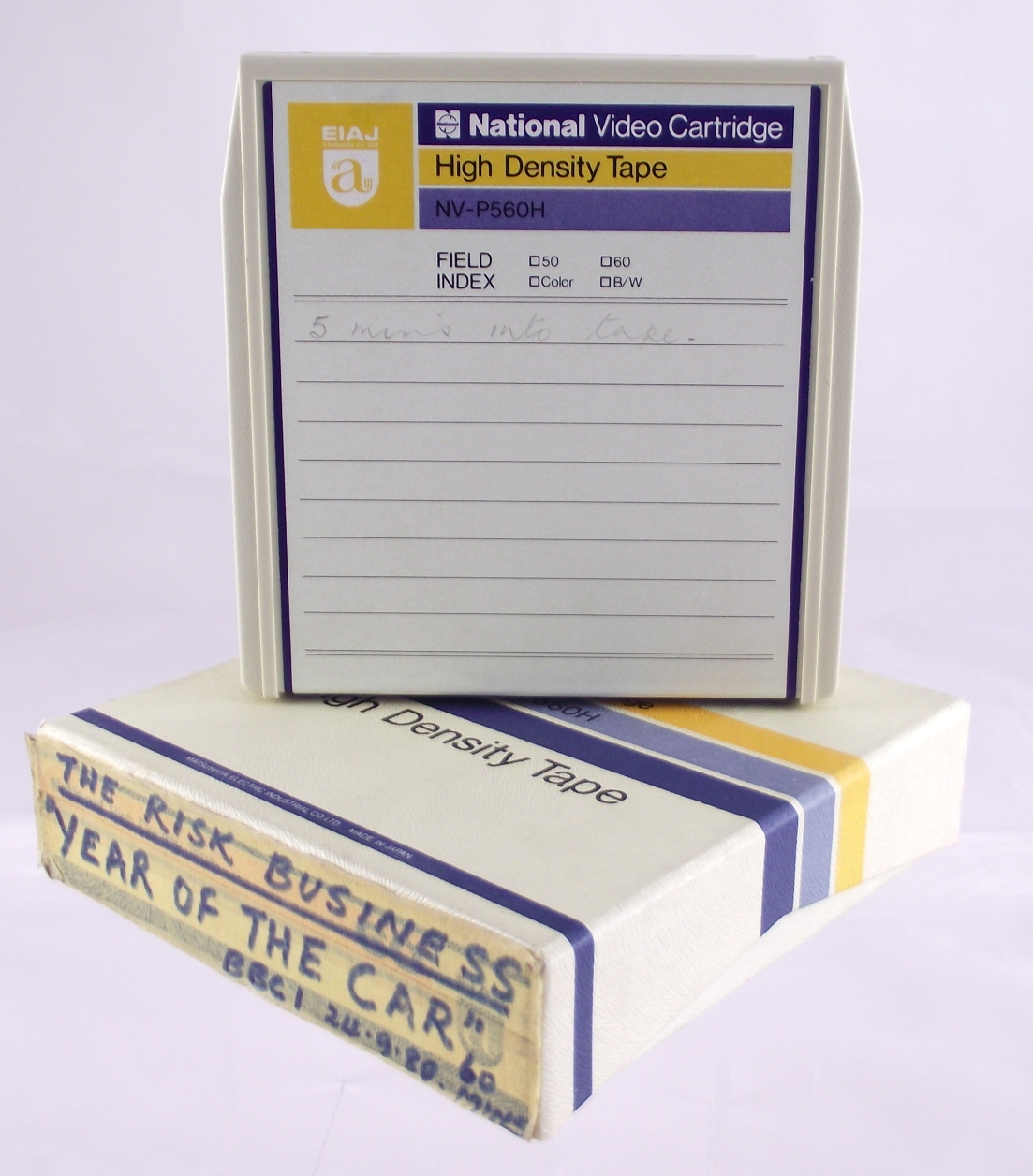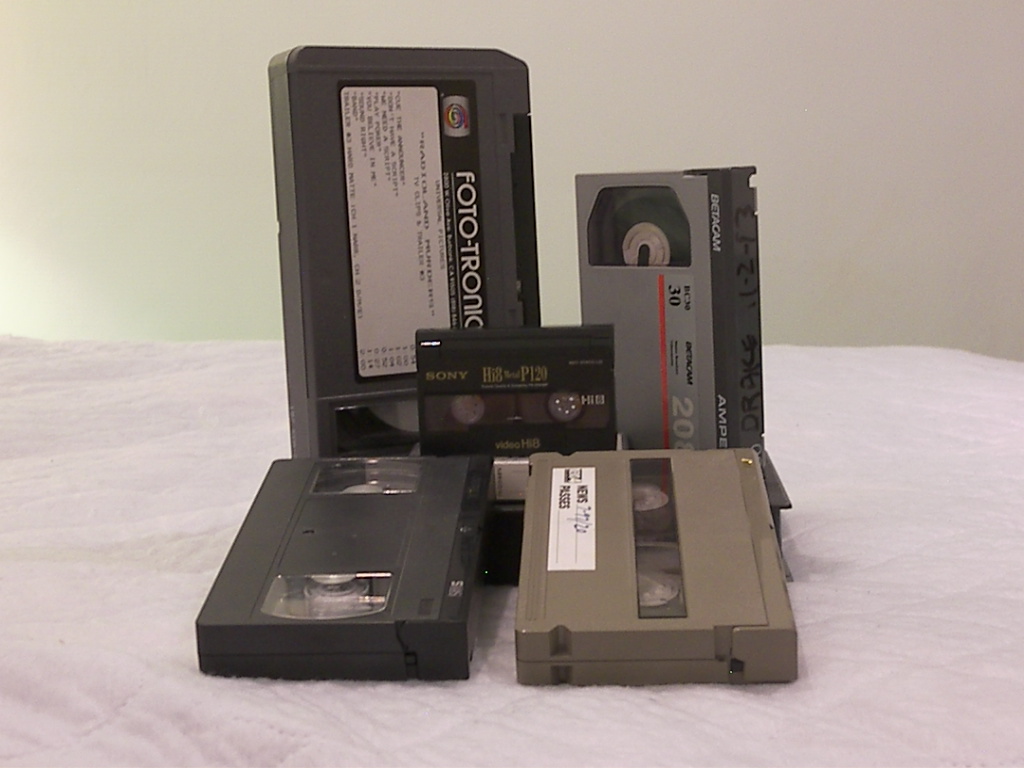|
VTR
A video tape recorder (VTR) is a tape recorder designed to record and playback video and audio material from magnetic tape. The early VTRs were open-reel devices that record on individual reels of 2-inch-wide (5.08 cm) tape. They were used in television studios, serving as a replacement for motion picture film stock and making recording for television applications cheaper and quicker. Beginning in 1963, videotape machines made instant replay during televised sporting events possible. Improved formats, in which the tape was contained inside a videocassette, were introduced around 1969; the machines which play them are called videocassette recorders. An agreement by Japanese manufacturers on a common standard recording format, which allowed cassettes recorded on one manufacturer's machine to play on another's, made a consumer market possible; and the first consumer videocassette recorder, which used the U-matic format, was introduced by Sony in 1971. History In early 195 ... [...More Info...] [...Related Items...] OR: [Wikipedia] [Google] [Baidu] |
Quadruplex Videotape
2-inch quadruplex videotape (also called 2" quad video tape or quadraplex) was the first practical and commercially successful analog recording video tape format. The format uses magnetic tape and was developed and released for the broadcast television industry in 1956 by Ampex, an American company based in Redwood City, California. The first videotape recorder using this format was built the same year. This format revolutionized broadcast television operations and television production, since the only recording medium available to the TV industry until then was motion picture film. Since most United States network broadcast delays by the television networks at the time used kinescope film that took time to develop, the networks wanted a more practical, cost-effective, and quicker way to time shifting, time-shift television programming for later airing in Western time zones than the expensive and time-consuming processing and editing of film. Faced with these challenges, broadc ... [...More Info...] [...Related Items...] OR: [Wikipedia] [Google] [Baidu] |
Ampex VR1000A (serial 329)
Ampex Data Systems Corporation is an American electronics company founded in 1944 by Alexander M. Poniatoff as a spin-off of Dalmo-Victor. The name ''AMPEX'' is an acronym, created by its founder, which stands for Alexander M. Poniatoff Excellence.AbramsoThe History of television, 1942 to 2000– McFarland, 2003 – , page 286, Chapter 2, footnote 34 "1944 he founded Ampex (the name was created from his initials, AMP, plus "ex" for excellence)" Ampex operates as Ampex Data Systems Corporation, a subsidiary of Delta Information Systems, and consists of two business units. The Silicon Valley unit, known internally as Ampex Data Systems (ADS), manufactures digital data storage systems capable of functioning in harsh environments. The Colorado Springs, Colorado, unit, referred to as Ampex Intelligent Systems (AIS), serves as a laboratory and hub for the company's line of industrial control systems, cyber security products and services and its artificial intelligence/machine learni ... [...More Info...] [...Related Items...] OR: [Wikipedia] [Google] [Baidu] |
Ampex
Ampex Data Systems Corporation is an American electronics company founded in 1944 by Alexander M. Poniatoff as a spin-off of Dalmo-Victor. The name ''AMPEX'' is an acronym, created by its founder, which stands for Alexander M. Poniatoff Excellence.AbramsoThe History of television, 1942 to 2000– McFarland, 2003 – , page 286, Chapter 2, footnote 34 "1944 he founded Ampex (the name was created from his initials, AMP, plus "ex" for excellence)" Ampex operates as Ampex Data Systems Corporation, a subsidiary of Delta Information Systems, and consists of two business units. The Silicon Valley unit, known internally as Ampex Data Systems (ADS), manufactures digital data storage systems capable of functioning in harsh environments. The Colorado Springs, Colorado, unit, referred to as Ampex Intelligent Systems (AIS), serves as a laboratory and hub for the company's line of industrial control systems, cyber security products and services and its artificial intelligence/machine learnin ... [...More Info...] [...Related Items...] OR: [Wikipedia] [Google] [Baidu] |
EIAJ-1
EIAJ-1 was a standard for video tape recorders (VTRs) developed by the Electronic Industries Association of Japan with the cooperation and assistance of several Japanese electronics manufacturers in 1969. It was the first standardized format for industrial/non-broadcast VTRs using a helical scan system employing open reel tape. Previously, each manufacturer of machines in this market used a different proprietary format, with differing tape speeds, scanner drum diameters, bias frequencies, tracking head placement, and so on, although most used 1/2" wide tape. As a result, video tapes recorded on one make and/or model of VTR could only be interchanged with other machines using that specific format, hampering compatibility. For example, a reel of tape recorded on a Panasonic machine would not play on a Sony machine, and vice versa. The EIAJ-1 standard ended this incompatibility, giving those manufacturers a standardized format, interchangeable with almost all VTRs subsequently ... [...More Info...] [...Related Items...] OR: [Wikipedia] [Google] [Baidu] |
Videocassette Recorder
A videocassette recorder (VCR) or video recorder is an electromechanical device that records analog audio and analog video from broadcast television or other AV sources and can play back the recording after rewinding. The use of a VCR to record a television program to play back at a more convenient time is commonly referred to as ''time shifting''. VCRs can also play back prerecorded tapes, which were widely available for purchase and rental starting in the 80s and 90s, most popularly in the VHS videocassette format. Blank tapes were sold to make recordings. VCRs declined in popularity during the 2000s and in 2016, Funai Electric, the last remaining manufacturer, ceased production. History Early machines and formats The history of the videocassette recorder follows the history of videotape recording in general. Ampex introduced the quadruplex videotape professional broadcast standard format with its Ampex VRX-1000 in 1956. It became the world's first commercially succe ... [...More Info...] [...Related Items...] OR: [Wikipedia] [Google] [Baidu] |
Video
Video is an Electronics, electronic medium for the recording, copying, playback, broadcasting, and display of moving picture, moving image, visual Media (communication), media. Video was first developed for mechanical television systems, which were quickly replaced by cathode-ray tube (CRT) systems, which, in turn, were replaced by flat-panel displays of several types. Video systems vary in display resolution, Display aspect ratio, aspect ratio, refresh rate, color capabilities, and other qualities. Analog and digital variants exist and can be carried on a variety of media, including radio broadcasts, magnetic tape, optical discs, Video file format, computer files, and Streaming media, network streaming. Etymology The word ''video'' comes from the Latin verb ''video,'' meaning to see or ''videre''. And as a noun, "that which is displayed on a (television) screen," History Analog video Video developed from facsimile systems developed in the mid-19th century. Early mecha ... [...More Info...] [...Related Items...] OR: [Wikipedia] [Google] [Baidu] |
Helical Scan
Helical scan is a method of recording high-frequency signals on magnetic tape, used in open-reel video tape recorders, video cassette recorders, digital audio tape recorders, and some computer tape drives. With this technique, magnetic tape heads (or head chips) are placed on a rotating head drum, which moves the chips at high speed by due to its high angular velocity. The speed of the head chips must be higher than the linear speed of the tape. The tape is wrapped tightly around the drum. The drum and/or the tape is tilted at an angle that allows the head chips to read the tape diagonally. The linear speed of the tape is slower than the speed of the head chips, allowing high frequency signals to be read or recorded, such as video. As the tape moves linearly or length-wise, the head chips move across the width of the tape in a diagonal path. Due to geometry, this allows for high head chip speeds, known as writing speeds, to be achieved in spite of the low linear speed of the tap ... [...More Info...] [...Related Items...] OR: [Wikipedia] [Google] [Baidu] |
Magnetic Tape
Magnetic tape is a medium for magnetic storage made of a thin, magnetizable coating on a long, narrow strip of plastic film. It was developed in Germany in 1928, based on the earlier magnetic wire recording from Denmark. Devices that use magnetic tape can with relative ease record and play back audio, visual, and binary computer data. Magnetic tape revolutionized sound recording and reproduction and broadcasting. It allowed radio, which had always been broadcast live, to be recorded for later or repeated airing. Since the early 1950s, magnetic tape has been used with computers to store large quantities of data and is still used for backup purposes. Magnetic tape begins to degrade after 10–20 years and therefore is not an ideal medium for long-term archival storage. The exception is data tape formats like Linear Tape-Open, LTO which are specifically designed for long-term archiving. Information in magnetic tapes is often recorded in tracks which are narrow and long areas of in ... [...More Info...] [...Related Items...] OR: [Wikipedia] [Google] [Baidu] |
Videocassette
Videotape is magnetic tape used for storing video and usually sound in addition. Information stored can be in the form of either an analog or digital signal. Videotape is used in both video tape recorders (VTRs) and, more commonly, videocassette recorders (VCRs) and camcorders. Videotapes have also been used for storing scientific or medical data, such as the data produced by an electrocardiogram. Because video signals have a very high bandwidth, and stationary heads would require extremely high tape speeds, in most cases, a helical-scan video head rotates against the moving tape to record the data in two dimensions. Tape is a linear method of storing information and thus imposes delays to access a portion of the tape that is not already against the heads. The early 2000s saw the introduction and rise to prominence of high-quality random-access video recording media such as hard disks and flash memory. Since then, videotape has been increasingly relegated to archival and s ... [...More Info...] [...Related Items...] OR: [Wikipedia] [Google] [Baidu] |
U-matic
U-matic, also known as -inch Type E Helical Scan or SMPTE E, is an analog recording videocassette format developed by Sony. First shown as a prototype in October 1969 and introduced commercially in September 1971, it was among the earliest video formats to house videotape inside a cassette, replacing the reel-to-reel systems common at the time. The format uses tape, earning it the nickname "three-quarter-inch" or simply "three-quarter," in contrast to larger open-reel formats like Type C videotape and quadruplex videotape. The name ''U-matic'' refers to the U-shaped tape path as it threads around the video drum. Unlike most cassette formats, U-matic's supply and take-up reels rotate in opposite directions during playback, fast-forward, and rewind—one clockwise, the other counterclockwise. Each cassette has an internal locking mechanism that secures the tape hubs during transport, and a spring-loaded door that protects the tape; this door automatically opens when the casse ... [...More Info...] [...Related Items...] OR: [Wikipedia] [Google] [Baidu] |
Bing Crosby
Harry Lillis "Bing" Crosby Jr. (May 3, 1903 – October 14, 1977) was an American singer, comedian, entertainer and actor. The first multimedia star, he was one of the most popular and influential musical artists of the 20th century worldwide. Crosby was a leader in record sales, network radio ratings, and motion picture grosses from 1926 to 1977. He was one of the first global cultural icons. Crosby made over 70 feature films and recorded more than 1,600 songs. Crosby's early career coincided with recording innovations that allowed him to develop an intimate singing style that influenced many male singers who followed, such as Frank Sinatra, Perry Como, Dean Martin, Dick Haymes, Elvis Presley, and John Lennon. Yank, the Army Weekly, ''Yank'' magazine said that Crosby was "the person who had done the most for the morale of overseas servicemen" during World War II. In 1948, American polls declared him the "most admired man alive", ahead of Jackie Robinson and Pope Pius XII. I ... [...More Info...] [...Related Items...] OR: [Wikipedia] [Google] [Baidu] |










